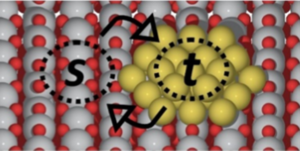
The ever higher demands for efficient catalytic conversion set by industry and environmental legislation is a major driver for catalyst design and discovery. The optimization of catalyst materials is, however, complicated by the fact that only few materials provide the optimal adsorption energies of key reaction intermediates, which allow for an efficient dissociation of the reactants without hindering the formation of the products. It is exactly the desire to overcome this problem that has led to the suggestion of bifunctional catalysis. The hope is that a bifunctional coupling of two different catalytic site types could increase catalytic activity by providing one specialized site for the dissociation of the reactants and another for the desorption of the products.
In our work we made use of simple linear parameter dependencies in catalysis – so-called scaling relations – to analyze bifunctional catalysis. We generally assessed the activity gains possible through such bifunctional coupling, specifically in the form of either a diffusional coupling (spillover) between two remote active sites or a direct coupling between two neighboring sites. The latter case could for example occur in well-mixed bimetallic alloy catalysts, where in addition to diffusion between the sites, there is also the possibility for a direct coupling arising from second-order reaction steps that involve two reaction intermediates adsorbed on different types of active sites. The main conclusion of our work is that appreciable gains in activity will only be possible through the coupling of materials with active sites that do not follow the same scaling relations, e.g. the diffusional spillover from a metal particle to an oxide support material. The results provide crucial guidelines for how the scaling parameters should vary and is therefore of high interest to both experimentalists and theoreticians working on catalyst optimization.
Read more about our work: